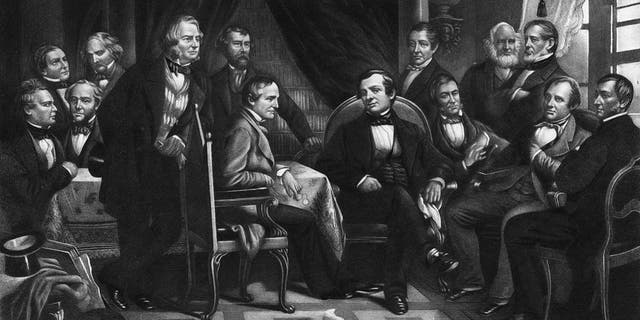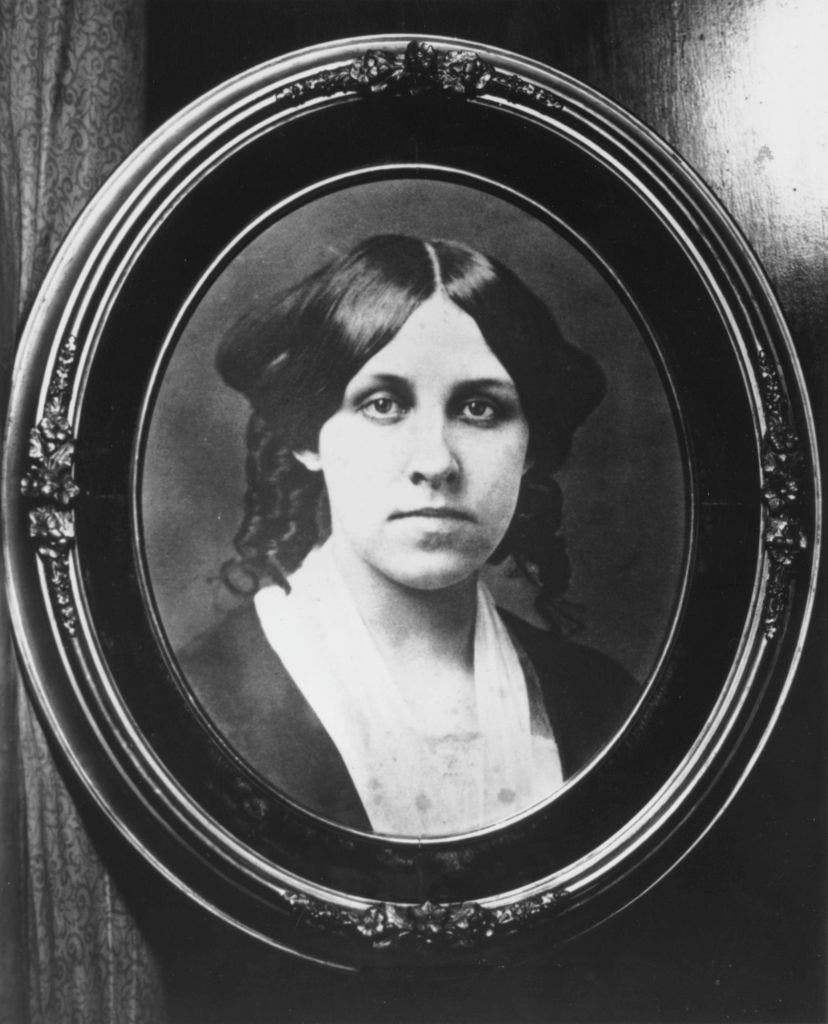The headless horseman of Sleepy Hollow haunts the American imagination each autumn.
New York City native Washington Irving breathed life into the galloping ghost in 1819, when he penned “The Legend of Sleepy Hollow,” one of his tales of life among Dutch settlers along the Hudson River.
It stands 203 years later as one of the most famous ghost stories in world history — remade in many versions and retold in scores of languages.
Irving rode the spooky steed himself into global fame and a legacy as the first international celebrity born in the new nation.
MEET THE AMERICAN WHO FAME US FLIP FOR FAST FOOD: WHITE CASTLE FOUNDER BILLY INGRAM
“He had talent, movie-star good looks and a charm that endeared him to his audience,” writes author Brian Jay Jones in his 2008 biography, “Washington Irving: An American Original.”
“He danced and drank with the glitterati.”

Engraved portrait of Washington Irving, an American writer, historian and diplomat, from the book "Old New York Yesterday and Today," 1922. Courtesy Internet Archive.
(Photo by Smith Collection/Gado/Getty Images)
Irving’s impact on American culture is felt today in surprising ways — far beyond his haunting tale of headless Hessian on horseback.
He gifted New York City with its “Gotham” moniker early in his career and was the first American to make his living purely by his pen. Irving served in the U.S. Army in the War of 1812, then spent much of his 30s and 40s traveling Europe.
“He had talent, movie-star good looks and a charm that endeared him to his audience.”
He wrote biographies of Mohammed, Christopher Columbus and his namesake, George Washington.
He influenced and inspired younger authors on both sides of the Atlantic: Nathaniel Hawthorne, Lord Byron, Charles Dickens and fellow masters of the ghost tale Edgar Allen Poe and Mary Shelley.

Sleepy Hollow graveyard, immortalized by Washington Irving as the burial site of the headless Hessian who haunted the region on horseback.
(Fox News Digital)
“Frankenstein” author Shelley penned him love letters; Irving rejected her advances.
Dickens fawned over Irving and credited the American’s Christmas writings for inspiring his own idealized images of a 19th-century English yuletide.
“Among Irving’s biggest contributions to Christmas in America was his promotion of St. Nicholas as a beloved character, laying the groundwork for the figure we’d eventually embrace as Santa Claus,” writes the National Endowment for the Humanities.
‘BANNED’ HALLOWEEN COSTUMES OVER TIME AS EBAY REMOVES JEFFREY DAHMER-INSPIRED OUTFIT
Irving wrote “so widely and imaginatively, in fact, that he’s often credited with creating Christmas in America as we know it.”
Dickens, only 30 years old, visited the famous American author in New York and met Irving’s brother, Ebenezer.
“‘Frankenstein’ author Mary Shelley penned Irving love letters; Charles Dickens fawned over him.”
The Englishman released “A Christmas Carol,” featuring curmudgeon Ebenezer Scrooge, the following year.
Irving wrote for popular and not critical acclaim, biographer Jones told Fox News Digital, yet stood at the top of the literary world in the 19th century.
The greats of the era gathered at his Hudson River home; the public snapped up every word he wrote; and President John Tyler named Irving minister to Spain in 1842, a post he held until 1846.

American author, biographer, historian and diplomat Washington Irving (center, sitting in black suit) with literary friends, circa 1830. From left, Oliver Wendell Holmes Sr., William Gilmore Simms, Fitz-Greene Halleck, Nathaniel Hawthorne, Henry Wadsworth Longfellow, Nathaniel Parker Willis, William Hickling Prescott, (Irving), James Kirke Paulding, Ralph Waldo Emerson, William Cullen Bryant, John Pendleton Kennedy, James Fenimore Cooper and George Bancroft. From an original engraving by Geo. E. Perine.
(Photo by Kean Collection/Getty Images)
The American author charmed the people of Europe, too.
A statue in Irving’s honor was dedicated outside Alhambra, the Andalusian fortress that he romanticized in his tales from Europe, in 2009 to celebrate the 150th anniversary of his death.
“His story is the kind on which America thrives,” writes Jones. “A likable, average man does something no one has ever done before and becomes very, very famous.”
Born with the new nation
Washington Irving was born in Manhattan on April 3, 1783.
His father William was a Scottish immigrant from the Orkney Island who achieved wealth as a New York City merchant; his mother Sarah (Sanders) Irving was descended from English clergy.
Irving came of age with the new nation. The United States defeated the British Empire in Yorktown in October 1781, only 18 months before Irving’s birth.
The Treaty of Paris, securing American independence in the eyes of the world, was signed on September 3, 1783, when Irving was just five months old.
PIE QUIZ! TEST YOUR KNOWLEDGE OF PIES IN THIS FUN LIFESTYLE QUIZ
He was raised on William Street in Lower Manhattan, steps from where George Washington was inaugurated on Wall Street as the first United States president in 1789.
A painting from decades later portrays the purported meeting of the two American icons sometime soon after the inauguration, with the middle-aged Father of His Country tapping the 6-year-old future Father of American Letters on the head.

Colonel Ichabod Bennet Crane, 1787-1857, pursued by the headless horseman. Digital improved reproduction of an original from the 19th century.
(Photo by: Universal Images Group via Getty Images)
The new nation needed its own people to shape its image.
Irving shaped that vision masterfully, pairing romanticized portraits of the American landscape with all-American hustle, and doing so from the catbird seat of a city and a nation bursting with opportunity.
He established his fame with a brazen marketing scheme. Irving took out ads in the local newspapers in 1809, purporting to be a hotel owner who found a manuscript left behind by a gentleman named Diedrich Knickerbocker.

American actors Johnny Depp and Christina Ricci on the set of "Sleepy Hollow," based on the story by Washington Irving, directed by Tim Burton.
(Getty Images)
“The ads said Knickerbocker skipped town and hadn’t paid his rent,” Dr. Elizabeth Bradley, an Irving biographer and vice president for Historic Hudson Valley, told Fox News Digital.
“The hotel owner threatened to publish the manuscript in order to recoup his debt should Knickerbocker not be found.”
Irving established his fame with a brazen marketing scheme.
The quest made for intense local gossip. City officials joined the search for the missing man.
But, of course, there was no Knickerbocker. Irving released the manuscript, “A History of New York,” under the Knickerbocker pen name.
“It was [a] great P.T. Barnum-style publicity hoax,” said Bradley. “It became an instant bestseller and launched Irving’s literary career.”
Knickerbocker would become the author of many other Irving tales — including one about a headless horseman.
Great American ghost story
“The Legend of Sleepy Hollow” juxtaposes the haunting specter of a headless horseman against the backdrop of the idyllic Hudson River countryside.

The Dutch church of Sleepy Hollow, New York, where a Hessian soldier who lost his head in battle was said to be buried, arising each night to search for his missing skull.
(Fox News Digital)
Residents of his “drowsy, dreamy” land of Sleepy Hollow are bewitched by “marvelous beliefs … trances and visions and frequently see strange sights, and hear music and voices in the air,” wrote Irving.
New York City had suffered a yellow fever epidemic in the 1790s when Irving was a teenager. He was sent up the Hudson River to live with relatives, where he most likely encountered the old Dutch ghost stories.
Sleepy Hollow’s most haunting specter “is the apparition of a figure on horseback … the ghost of Hessian trooper whose head had been carried away by a cannon-ball, in some nameless battle during the revolutionary war,” Irving wrote in his famous “Legend.”
The Horseman “rides forth to the scene of battle in a nightly quest for his head.” — Washington Irving
The ghost rises from its churchyard grave and “rides forth to the scene of battle in a nightly quest for his head.”
Irving writes breathlessly, channeling a chilly October night: “The rushing speed at which he sometimes passes along the Hollow, like a midnight blast, is owing to his being belated, and in a hurry to get back to the churchyard before daybreak.”
School teacher Ichabod Crane learns of the tale one night at a celebration at the home of a Dutch farmer. Afterward, on the way home, the skittish Crane realizes he is being followed though the dark of night.
“On mounting a rising ground, which brought the figure of his fellow-traveler in relief against the sky … Ichabod was horror-struck on perceiving that he was headless!” writes Irving.
HISTORY OF HALLOWEEN: ORIGINS OF THE HOLIDAY
“But his horror was still more increased, on observing that the head, which should have rested on his shoulders, was carried before him on the pommel of the saddle.”
The terrified schoolteacher boots his horse and races off in fear — “but the spectre started full jump with him.”
Crane is never seen nor heard from again by the people of Sleepy Hollow. Irving never reveals his fate, the mystery of his disappearance part of its enduring appeal.
Sleepy Hollow embraces haunting legacy
Irving died of a heart attack on Nov. 28, 1859, in his Hudson River mansion, Sunnyside, just south of where Ichabod Crane encountered the headless horseman of Sleepy Hollow.
He was 76 years old.

Washington Irving is buried in the same Dutch church graveyard he immortalized in "The Legend of Sleepy Hollow."
(Fox News Digital)
He is buried today in Sleepy Hollow’s old Dutch church cemetery — the same graveyard in which the maimed Hessian mercenary restlessly rose each night to haunt the countryside in search of his head.
His home, with its verdant riverfront location, is a local tourist attraction today.
The village of Sleepy Hollow (which has roughly 10,000 residents) has only recently embraced its legacy. Once known as North Tarrytown, it officially changed its name to Sleepy Hollow in 1996.
CLICK HERE TO SIGN UP FOR OUR LIFESTYLE NEWSLETTER
The Horsemen still ride each autumn when the Sleepy Hollow High School football team races onto the gridiron.
The Tarrytown and Sleepy Hollow regions, long an ideal location for autumn leaf-peeping, is now a hotspot of Halloween activity — all of it made possible by Irving’s 200-year-old ghost story.

The Sleepy Hollow High School sports teams are known as the Horsemen, thanks to Washington Irving.
(Fox News Digital)
Irving’s pen name Diedrich Knickerbocker remains on the lips of millions of Americans — even if they don’t know it. The author’s tales of the Hudson River were so popular in the 1800s that the name “Knickerbocker” became a synonym for a New York City resident.
The NBA embraced Irving’s legacy in 1946, when New York’s professional basketball team was dubbed the Knickerbockers, though shortened in more recent years to Knicks.
The historic Knickerbocker Hotel sits in Times Square today, literally in the heart of America’s biggest city.

RJ Barrett, No. 9 of the New York Knicks, looks on during the second half against the Brooklyn Nets at Madison Square Garden on April 6, 2022, in New York City. The Knicks are named for Washington Irvin literary character and pseudonym Diedrich Knickerbocker.
(Sarah Stier/Getty Images)
New York City beer maker Jacob Ruppert made his fortune brewing and selling Knickerbocker beer. He bought the New York Yankees in 1915 and five years later swindled Babe Ruth away from the Red Sox — reshaping American sports history on the back of the treasure he accrued from Knickerbocker beer.
CLICK HERE TO GET THE FOX NEWS APP
Yet it’s the ghoulish image of the headless Hessian horseman, forever galloping through the Hudson River countryside, that remains Irving’s most memorable legacy and makes Sleepy Hollow synonymous with the great American ghost story.
“You can’t go to Hogwarts but you can go Sleepy Hollow and see all the landmarks of the American legend,” said Bradley.
To read more stories in this unique “Meet the American Who…” series from Fox News Digital, click here.
 Iktodaypk Latest international news, sport and comment
Iktodaypk Latest international news, sport and comment







